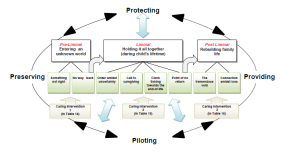This September is childhood cancer awareness month and today’s blog focuses on the subject of parental grief.
Today’s guest blog comes from Ciara Barr, a nurse and doctoral research student from the School of Nursing & Midwifery in Queen’s University Belfast. Ciara’s PhD title is: Losing a Child: Multi-national case study to gain better understanding of parental need for bereavement support to inform service development.
A better understanding of parental grief
In recent years there has been an increased acknowledgement by those working with bereaved parents that traditional grief theoretical perspectives do not concisely reflect the true experiences of parental grief. Early stage theories of grief are considered to be too rigid as they focus on breaking bonds with the deceased and stress the importance of ‘moving on’ as quickly as possible. Later theories conceptualised grief as a movement through stages and tasks and even more recent theories have evolved which consider finding an enduring connection with the deceased. This has relevance to those grieving the loss of a child and research with bereaved parents will inevitably have to consider theory, as long held views about the grief experience and grief therapy have undergone transformational change.
To try and better understand grief from the perspective of a parent it is beneficial to consider doing so with a framework which provides a thorough representation of the needs and experiences of losing a child. One such framework that coherently describes a parent’s journey through the entire trajectory of their child’s palliative care experience, from diagnosis and into bereavement is that of Price et al. (2011); Piloting, Providing, Protecting and Preserving. Interestingly, this conceptual framework could be applicable for the death of an adult also.
Figure 1. Piloting, Providing, Protecting and Preserving- a framework of parent’s experiences living through the death of their child (Price et al. 2011). Click Image to Enlarge.
A brief overview of each process within the framework provides a better understanding of parents actively ‘doing’, thus enabling coping. The piloting, providing, protecting and preserving processes are evident throughout the entire trajectory of the child’s illness, death and beyond and do not occur in a rigid linear fashion. Here the processes are presented from a post bereavement perspective.
Piloting
This process is concerned with the manner in which parents steer their way through the bereavement trajectory. In trying to navigate their way through unchartered territory, from immediate bereavement and into the later stages many months and years later, parents can experience a multitude of unfamiliar and bewildering emotions. During the piloting process parents attempt to maintain control and create a new ‘normal’, perhaps having to make complex decisions whilst at the same time trying to maintain family functioning. Often during this process parents may have to juggle roles in attempt to manoeuvre themselves and their families, as best they can, through the difficulties they may be experiencing.
Providing
Providing is concerned with being there for other family members both physically and emotionally. Parents are a source of comfort for other family members including other children and close relatives. Providing comfort is natural for a parent but can prove difficult as they try to make sense of their new world without their child. As partners, the relationship between parents can become strained as they try to understand each other’s thoughts and feelings, be there for each other emotionally and physically, and try to provide comfort for others in the family.
Protecting
A child’s death impacts on all family members and parents want to protect other children and adult family members from harm, which may be real or potential. Parents may overprotect remaining children as the uncertainty of life has been reinforced and they can become concerned about the possibility of another death. Parents recognise their role as protectors but can feel helpless when they cannot protect their own children from death. Protecting the child from being forgotten plays an important role in bereavement, and indeed for the rest of the parent’s life. Continued contact with staff that cared for the child, participation of bereavement programmes, creating memorials, keeping the child’s possessions and photographs, and setting up foundations or raising money for various causes are some of the ways that parents act to protect their child’s memory.
Preserving
Preserving is primarily concerned with maintaining the family unit, which itself may be a source of healing for family members. Normal family functioning is altered after the death of a child, and as an attempt to maintain relationships within families parents may come to rely on professional or non-professional support. Similar to the process of protecting, preserving is also concerned with preservation of the child’s memory and place within the family unit. Parents show a preference for maintaining and preserving relationships with the care providers that were involved in their child’s care. Maintaining relationships such as this enables parents to actively remember their child and it is this bond that can influence where parents seek support from after the death of their child.
Each bereavement experience is unique, yet frameworks such as this help others to gain a better understanding of the needs and experiences of bereaved parents.
Ciara Barr @CiaraBarrRN
References
Price, P., Jordan, J., Prior, L. & Parkes, J. (2011) Living through the death of a child: A qualitative study of bereaved parents’ experiences. International Journal of Nursing Studies. 48 pp1384-1392

